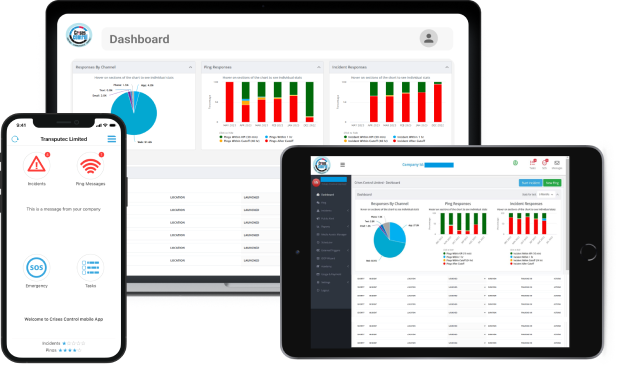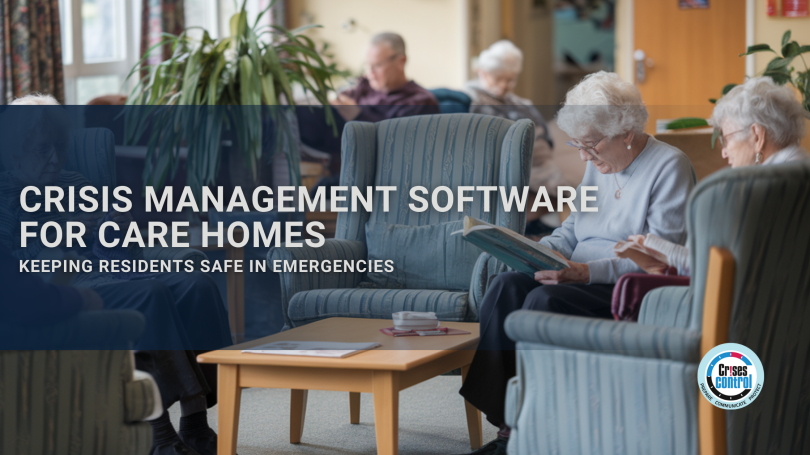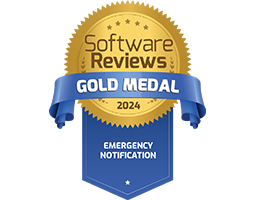Written by Anneri Fourie | Crises Control Executive
Why Emergency Response in Care Homes Must Be Fast and Effective
Care homes are responsible for some of the most vulnerable people in our communities, residents with limited mobility, cognitive impairments, or serious medical conditions. When an emergency strikes, a fire, power outage, security breach, or extreme weather, staff must act quickly to protect those in their care.
But here’s the challenge: many care homes still rely on outdated emergency response methods. Paper-based plans, phone trees, and intercom systems are slow and unreliable when every second matters. These manual processes can lead to confusion, delays, and errors, putting both residents and staff at risk.
This is where Crisis Management Software makes a difference. By automating emergency alerts, coordinating response efforts, and ensuring clear communication, care homes can act faster and more efficiently. Crises Control provides a powerful, digital solution that helps care homes respond swiftly, integrate emergency plans, and meet compliance requirements, all while ensuring the highest level of safety for residents and staff.
And it’s not just care homes that benefit. While this blog focuses on the challenges of elderly care, the same principles apply to hospitals, schools, office buildings, and any organisation where rapid emergency response is essential.
The Biggest Challenges Care Homes Face in an Emergency
Unlike hospitals with large teams and advanced infrastructure, care homes operate with fewer resources and often rely on quick decision-making during emergencies. Here are some of the biggest challenges:
1. Slow Communication When Every Second Matters
Many care homes still use landlines, pagers, or intercom systems to alert staff during an emergency. But what happens when a fire breaks out in the kitchen? Or when a resident suffers a stroke in their room? Delays in communication can mean the difference between life and death.
With a mass notification system, staff can receive alerts instantly via SMS, email, mobile app notifications, and even automated voice calls. Instead of running down the hall to find help, a caregiver can send an alert in seconds, ensuring the right people are notified immediately.
2. Coordinating Staff Across Multiple Areas
Care home staff are constantly on the move, assisting residents, managing medication, and handling daily tasks. During an emergency, it’s critical that everyone is on the same page.
A mass notification system ensures that alerts reach every staff member instantly, no matter where they are. Whether it’s an evacuation order, a security alert, or a severe weather warning, clear instructions help staff respond without confusion.
3. Meeting Compliance and Safety Regulations
Care homes must follow strict health and safety regulations, ensuring they have well-documented emergency response plans. Failure to meet these standards isn’t just a legal issue, it puts lives at risk.
Regulators require clear records of how emergencies are handled. But manual reporting can be time-consuming and prone to errors. With a digital crisis management system, every action taken during an emergency is automatically logged, providing a transparent audit trail that proves compliance.
4. Protecting Residents Who Require Special Assistance
Many residents have mobility challenges, rely on oxygen tanks, or need specialised medical support during an evacuation. Without a clear plan, staff may struggle to assist everyone safely.
A digital emergency response system ensures that staff receive step-by-step instructions tailored to each type of emergency, whether it’s an evacuation, a medical crisis, or a power failure affecting life, supporting equipment.
How Crisis Management Software Improves Emergency Response in Care Homes
1. Instant Mass Notifications to Staff, Emergency Services, and Families
During an emergency, there’s no time for phone trees or manual alerts. A mass notification system allows care homes to send real-time alerts to:
- On-site staff: to coordinate response efforts
- Emergency responders: ensuring immediate action
- Family members: keeping them informed about their loved ones
By sending alerts across multiple channels (SMS, email, mobile app, and voice calls), no critical message is missed.
2. Digital Emergency Plans for Faster Decision-Making
Having an emergency plan is not enough, staff need immediate access to step-by-step instructions. With a digital crisis management system, all emergency protocols are stored securely in the cloud and accessible from any device.
This means:
- No more flipping through paper binders in a crisis
- Staff instantly know their assigned tasks
- Emergency response is structured and efficient
3. SOS Panic Button for Medical Emergencies
When a resident has a medical emergency, staff need to act immediately. With Crises Control’s SOS Panic Button, caregivers can send an instant emergency alert from their mobile device, notifying the on-site medical team and emergency services in seconds.
4. Temperature Monitoring for Medication Safety
Many care homes store temperature-sensitive medications, such as insulin or vaccines, that must be kept within a safe range. A sudden temperature fluctuation can compromise medication safety, putting residents at risk.
Crises Control can integrate with temperature monitoring systems to automatically send alerts if storage conditions become unsafe, allowing staff to take immediate action before medication is affected.
5. Compliance and Incident Reporting at Your Fingertips
Regulators require care homes to document every emergency incident. Crises Control offers:
- Real-time incident tracking to monitor events as they unfold
- Automated post-incident reports to ensure compliance
- Detailed records for audits and investigations
This eliminates the need for manual reports and ensures that care homes have accurate records for regulatory compliance.
Why Every Care Home Needs a Digital Crisis Management System
Traditional emergency response methods; manual phone calls, paper-based plans, and verbal alerts, are too slow. A digital crisis management system ensures that care homes can:
- Respond faster: Staff receive instant emergency alerts across multiple channels.
- Coordinate teams seamlessly: Whether in different buildings or shifts, all staff are instantly informed.
- Reduce human error: Automatic notifications and task assignments remove confusion.
- Meet compliance standards: Detailed reports ensure full regulatory transparency.
Conclusion: Protect Residents and Staff with Crises Control
Emergencies in care homes can escalate in seconds. Whether it’s a fire, security breach, or medical emergency, a slow response can put lives at risk. Care homes need a system that acts instantly.
Crises Control ensures that staff are always prepared, communication is seamless, and residents receive the fastest possible care. With real-time alerts, automated emergency plans, and compliance-ready reporting, Crises Control is the ultimate crisis management solution for care homes and beyond.
Don’t wait until an emergency happens. Protect your residents and staff today.
Get a free personalised demo of Crises Control now.
Request a FREE Demo









